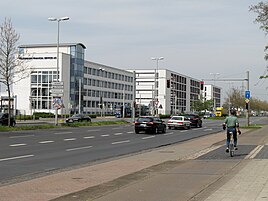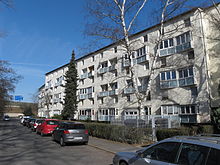Boast
|
Boast
City of Braunschweig
|
|
|---|---|
| Coordinates: 52 ° 18 ′ 15 ″ N , 10 ° 31 ′ 0 ″ E | |
| Height : | 75 m above sea level NN |
| Residents : | 2977 (Dec. 31, 2015) |
| Incorporation : | 1934 |
| Postal code : | 38112 |
| Area code : | 0531 |
|
Location of Rühme in Braunschweig
|
|
|
Gifhorner Strasse
|
|
Rühme is a district of Braunschweig located around four kilometers north of the core city and belongs to the city district 322 - Veltenhof-Rühme .
history
There are numerous indications that this area was already used as a settlement area in the early days. Stone axes and tools made of flint material from the Bronze or Iron Ages have been found. The clustered village of Rühme is located on the western bank of the Ohe flowing to the Schunter and the old arms of the Schunter, the farms of the farmers were on the back of the dunes that used to be here.
Rühme was first mentioned in documents on January 24, 1007 as "Riudum" or "Riudun" in the Steterburger Kopialbuch , later the settlement appeared under "Rudern" and 1605 as "Ruhem" (Riedheim) in documents. Since the Magni Church was founded in 1031 , the settlement belonged to this parish until 1948. Until 1936, Rühme had neither its own church, nor a pastorate nor a cemetery.
From the 13th century, the village became part of the defensive ring around the city of Braunschweig. It became a so-called "stake village". For this purpose , a defense tower (the turning tower around 1400), a customs station and a forge were built at the Braunschweiger Landwehr , west of the village . The tower is mentioned in 1444 as "torn to turn" and from 1774 to 1864 it was used as a customs station, until 1887 road tolls were still levied in Rühme . In 1852, six of the eleven farms were destroyed in a fire and rebuilt on the western bank of the Schunter.
Lincoln settlement
In 1952 a new residential complex was built for the city of Braunschweig as part of the Marshall Plan . A field between the village of Rühme and the motorway was chosen as a suitable site. It was here on April 18, 1952, that the foundation stone was laid for the settlement named after Abraham Lincoln . This was completed on November 9, 1952.
The complex consisted of 15 groupings of terraced houses and three larger apartment blocks. The architecture of the building was based on the fixed specifications and the funds made available. So they were built from the point of view of practicality, inexpensive and in a simple style.
When families moved into the Lincoln Settlement, the school building in Rühme became too small. Therefore, the construction of a new elementary school in the area of the turning tower was started. The first building was inaugurated on August 6, 1953. The second construction phase was handed over to its intended purpose in April 1959 and the school could start operating. 15 rooms were now available for 15 classes, and in 1966 a gym was added.
The Lincoln settlement together with the town center Rühme belongs to the statistical district 41 - Rühme Ost, in which 1484 inhabitants live.
Vorwerkiedlung
The Vorwerk settlement was built between 1938 and 1940 in the Rühmer Feldmark for the employees of the Volkswagen Vorwerk . It initially offered around 400 apartments in two-storey construction.
The streets of the newly built settlement were named after Austrian cities and countries, as Austria was annexed to the German Empire shortly before . Except for Riesebergstrasse, which was originally named Braunauer Strasse after Adolf Hitler's birthplace, all streets still bear their original names.
In the mid-1950s, more apartments were built, including homeless apartments, which gave the settlement the dysphemism of the “Mau Mau settlement”.
The Vorwerkiedlung - statistical district 42 - has 1306 inhabitants.
Economy and industry
Up until the beginning of industrialization, Rühme was an agricultural village, but after that handicraft businesses settled and a chicory and canning factory were established .
The newer companies that have settled in Rühme come, in addition to the retail trade to supply the residents, mainly from the automotive industry. The Volkswagen plant in Braunschweig and the headquarters of Volkswagen Financial Services AG are located in the south, and numerous car dealerships from various manufacturers and service providers along Gifhorner Strasse.
In the commercial and industrial area of Schmalbachstrasse / Porschestrasse are the TÜV test center and the road traffic office.
Infrastructure
traffic
With the Autobahn connection Hansestraße, Rühme has a direct connection to the Braunschweig Westtangente ( A 391 ) and via the nearby Braunschweig-Nord motorway junction to the A 2 to Hanover and Berlin.
In public transport, Rühme has a direct tram connection to the city center with line 1, as well as bus connections to the surrounding districts from the Lincoln settlement.
Public facilities
In addition to a day care center, Rühme has a primary school and the Astrid Lindgren special school with a focus on learning on the same site.
In 2008, the Volkswagen company kindergarten Frech-Daxe was to open on Maybachstrasse . Since the Maybach factory belongs to Daimler AG, the group pushed for part of the street to be renamed. Maybachstrasse was rededicated from kindergarten and is called Käferweg from there.
Rühme has had its own volunteer fire brigade with an attached youth department ( youth fire brigade ) since 1874 and provides fire protection and general help, especially at the local level. Together with the Ölper and Lehndorf fire brigades , it forms the special train 87 "water pumping" and was equipped in 2009 with a portable pump vehicle with water (TSF-W) and equipment trolley logistics 2 (GW-L2) for the transport of hose lines.
Churches
The St. Trinitatis Church on Osterbergstrasse belongs to the Evangelical Lutheran parish of St. Trinitatis zu Rühme and Veltenhof . It was built in 1936 as a cemetery chapel.
The Catholic St. Christophorus Church is located on Hesterkamp. The church was built in 1961/62, the adjacent parish hall in 1992/93. Today the church belongs to the parish of St. Aegidien .
societies
- The only club with a sporting orientation is the sports association Rühme von 1921 eV with the departments tennis, soccer, darts, shooting and gymnastics / gymnastics.
- The second association is the Allotment Garden Association Heideland eV in the north of Rühme.
Entertainment and gastronomy
In addition to the club houses of SV Rühme and KGV Heideland, several restaurateurs have settled in Rühme, such as the "Restaurant in the Wendenturm", the "Gasthaus Campe" in the center of the village and the "Kegelcenter Nord".
coat of arms
The coat of arms shows a centrally arranged silver tower, which is flanked by two silver cattails on a red shield.
The cattails give the old name of the place (Riedheim) "of course". The tower symbolizes the turning tower as a defense tower of the Braunschweiger Landwehr. The colors red and white correspond to those of the city of Braunschweig and represent the centuries-old connection with it.
Arnold Rabbow designed the coat of arms, it was adopted on July 10, 1980 by the town hall in Rühme.
Personalities
- Willi Giesemann (* 1937 in Rühme), former national soccer player
- Joachim Bäse (* 1939 in Rühme), former national soccer player
Web links
- Boast on braunschweig.de
Individual evidence
- ↑ a b c population statistics on braunschweig.de
- ↑ a b c boast on braunschweig.de
- ^ A b Arnold Rabbow: New Braunschweigisches Wappenbuch. Braunschweiger Zeitungsverlag, Meyer Verlag, Braunschweig 2003, ISBN 3-926701-59-5 , pp. 25/26.
- ↑ Chronicle ( Memento of the original from December 28, 2015 in the Internet Archive ) Info: The archive link was inserted automatically and not yet checked. Please check the original and archive link according to the instructions and then remove this notice. on bs-ruehme.de
- ↑ Volker Abrolat: Rühme: 1007-2007; the story of a village between Schunter and Oker - from a settlement in the reeds to an industrial and banking location Braunschweigs Oeding, Braunschweig 2007, p. 213.







